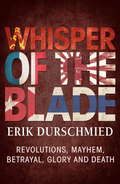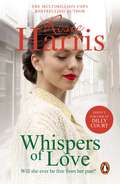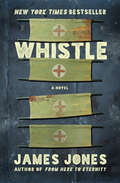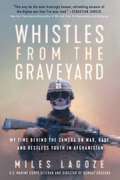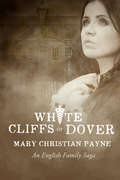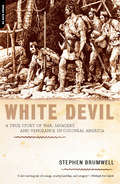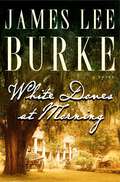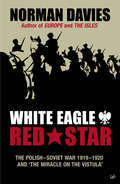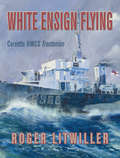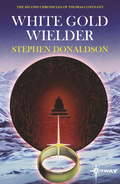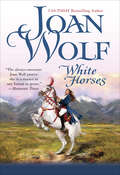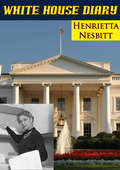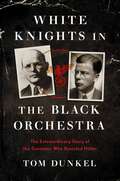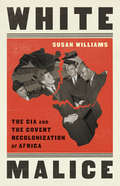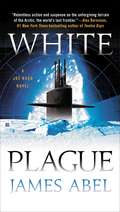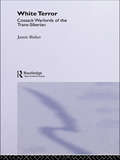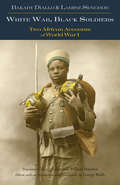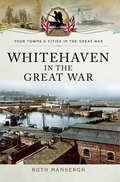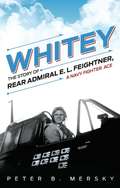- Table View
- List View
Whisper No Lies: Show No Mercy, Take No Prisoners, Whisper No Lies, And An Excerpt From With No Remorse (Black Ops, Inc. Ser. #No. 3)
by Cindy GerardIn New York Times bestselling author Cindy Gerard's fiery new romantic suspense series, when danger threatens, the seductive heroes of Black Ops, Inc. turn up the heat. AN INDECENT PROPOSAL... When a high roller at the Vegas casino where Crystal Debrowski manages security makes a scandalous proposition, she flat-out refuses, especially given rumors of his shady overseas connections. But then counterfeit bills mysteriously flood the gaming tables, and her reputation -- and her life -- are on the line. REVEALS A SIMMERING DESIRE... Despite his big, flirty grin, Texas heartbreaker Johnny Duane Reed can't get sassy Crystal off his mind. When she is abducted by an international crime lord with a threatening obsession, Reed enlists his Black Ops, Inc. team to pursue a dangerous mission to rescue her. ...WITH DEADLY CONSEQUENCES. Between Crystal and Johnny burns a scorching flame, but as they battle her relentless abductor, they uncover a malicious arms trafficking and white slavery ring. Together, they must destroy the tyrant's wicked enterprises or face his reign of terror themselves....
Whisper of the Blade: Revolutions, Mayhem, Betrayal, Glory and Death
by Erik DurschmiedRevolution brings tragedy, terror and heroism. Using historical texts and eye witness accounts as well as his own interviews, Erik Durschmied shares his unique understanding of revolutionary events that have shaped the course of history.His curiosity and amazement are reflected in the pages as is his irreverence for the conventional recitation of history.Progressing from the 18th to the 20th century, Durschmied provides a remarkable snapshot of the French Revolution; the Red October rising in Russia; Operation Walküre in Germany; Che Guevara's exploits; the rise and fall of Emperor Hirohito in Japan and the fall of the Shah of Iran in these powerful stories.
Whisper of the Blade: Revolutions, Mayhem, Betrayal, Glory and Death
by Erik DurschmiedRevolution brings tragedy, terror and heroism. Using historical texts and eye witness accounts as well as his own interviews, Erik Durschmied shares his unique understanding of revolutionary events that have shaped the course of history.His curiosity and amazement are reflected in the pages as is his irreverence for the conventional recitation of history.Progressing from the 18th to the 20th century, Durschmied provides a remarkable snapshot of the French Revolution; the Red October rising in Russia; Operation Walküre in Germany; Che Guevara's exploits; the rise and fall of Emperor Hirohito in Japan and the fall of the Shah of Iran in these powerful stories.
Whispers of Love: a compelling and heartfelt saga set in Liverpool at the outbreak of WW1
by Rosie HarrisLet much-loved multi-million copy bestseller Rosie Harris take you back in time with this beautifully moving family saga of love, life and trauma. Fans of Dilly Court, Kitty Neale, Emma Hornby and Rosie Goodwin will not be disappointed! WHAT READERS ARE SAYING!'A page-turner from the very first page' -- ***** Reader review'I loved this book and read it in a couple of days' -- ***** Reader review'Excellent' -- ***** Reader review***********************************************************************************WILL SHE EVER BE FREE FROM HER PAST?1914: Christabel Montgomery is happily preparing for her wedding when she receives the shattering news that her fiancé has been drowned at sea. Heartbroken, she tries to piece her life together. But she soon discovers she is pregnant, and fearing her parents would throw her out if they knew, she decides to help the war effort by leaving home to become a nurse.However, she is soon forced to give up her duties. And alone and desperate, she has little choice but to have the baby adopted.Determined to put her sorrows behind her, Christabel hopes to build a better future for herself. But circumstances compel her to return home again. And here she finds her situation ever more difficult. She envies her brother's wife Violet who has just had a new baby and she is filled with remorse and regret about what she has done.She had no alternative, for her sake and the baby's, but she wonders if she'll ever be free from the fateful decision she made...
Whistle
by James JonesThe crowning novel of James Jones's trilogy brings to life the men who fought and died in the war and the wounded who survived, living to carry the madness home.
Whistle: From Here To Eternity, Whistle, And The Thin Red Line (The World War II Trilogy #3)
by James JonesFour World War II infantrymen recover at an army hospital, and struggle to readjust to the home front, in this New York Times–bestselling novel. At the end of a long journey across the Pacific, a ship catches sight of California. On board are hundreds of injured soldiers, survivors of the American infantry&’s battle to wrest the South Seas from the Japanese Empire. As the men on deck cheer their imminent return to their families, wives, and favorite girls, four stay below, unable to join in the celebration. These men are broken by war and haunted by what they learned there of the savagery of mankind. As they convalesce in a hospital in Memphis, the pain of that knowledge will torment them far worse than any wound. The third of James Jones&’s epics based on his life in the army, this posthumously published novel draws on his own experiences to depict the horrors of war and their persistence even after the jungle is left behind. This ebook features an illustrated biography of James Jones including rare photos from the author&’s estate.
Whistles from the Graveyard: My Time Behind the Camera on War, Rage, and Restless Youth in Afghanistan
by Miles Lagoze&“The most bracingly honest, refreshing account of the Afghan war&” (Sebastian Junger, New York Times bestselling author) from a Marine Corps Combat Cameraman and director of the acclaimed documentary Combat Obscura.At just eighteen years old, Miles Lagoze joined the Marine Corps a decade after the war began and found himself surrounded by people not unlike those he&’d left behind at home—aimless youth searching for stability, community, and economic security. Deployed to Afghanistan as a Combat Cameraman—an active-duty videographer and photographer—Lagoze produced slick images of glory and heroism for public consumption. But his government-approved footage concealed a grim reality. Here, Lagoze pulls back the curtain and illustrates the grisly truth of the longest war in American history. As these young men and women were deployed to an unfamiliar country half a world away—history&’s &“graveyard of empires&”—they carried the scars of the fractured homeland that sent them. Lagoze shows us Marines straddling the edge of chaos. We see forces desensitized to gore and suffering by the darkest reaches of the internet, unsure of their places in an unraveling world and set further adrift by the uncertain mission to which they had been assigned abroad. Whistles from the Graveyard shows the parts of the Afghanistan War we were never meant to see—Afghan locals and American infantry drawn together by their fears of the ghostly, ever-present terror of the Taliban; moments of dark resignation as the devastating toll of years in war&’s crossfire reveals itself between bouts of adrenaline-laced violence; and nights of reckless, drug-fueled abandon to dull the pain. In full, vivid color, Miles Lagoze shows us an oft-overlooked generation of young Americans we cast out into the desert, steeped in nihilism, and shipped back home with firsthand training in extremism, misanthropy, and insurrection.
White Christmas: The new heartwarming historical fiction romance book to curl up with at Christmas from the Sunday Times bestselling author
by Katie Flynn** THE PERFECT NOVEL TO CURL UP WITH THIS WINTER, FROM THE BELOVED SUNDAY TIMES BESTSELLING AUTHOR KATIE FLYNN **December, 1938Rozalin Sachs has grown up in the vibrant city of Frankfurt. But with the Nazi Revolution gaining power, her family is forced to flee Germany. When a tragic accident separates Roz from her parents, she finds herself aboard the Kindertransport bound for Holland.Here Roz meets a young lad called Felix and they vow to stick together as their journey takes them to England. Eventually they find themselves in Liverpool with the promise of a new life, until a devastating incident takes Felix away. And, in a desperate attempt to escape the terrible situation she has found herself in, Roz decides to join the Women's Land Army.On the sprawling farm at Hollybank, Roz meets Bernie, a dashing farmer's son, who has more than just friendship on his mind. Roz is flattered by his affections, but will he win her heart, or will her love for Felix remain as strong as ever?Rose and Promise, Sunday Times bestseller, February 2023
White Cliffs of Dover: An English Family Saga
by Mary Christian PayneAs the world teeters on the brink of war, one woman’s steadfast heart will see her through. The stirring conclusion to the epic Claybourne trilogy. Spanning the years from 1925 through 1945, Lily Claybourne, the Countess of Gloucester, forges her path after her struggles during World War I.Despite difficulties with her marriage, her dreams remain intact, and she strives to make them a reality. She enters into a tumultuous time in her life, filled with great achievement and heartbreaking loss. Through it all, Lily continues to grow, and refuses to let misfortune block her way.This is an engaging finale to the much-loved trilogy which began in 1914, at the beginning of the Great War. Lily moves through the 1930s and 40s with renewed purpose and strength. In the end, the reader learns what becomes of each character with whom they have become intimately acquainted in this engrossing chronicle of a British family’s life in the first half of the twentieth century.Don’t miss the first two books in the Claybourne Trilogy: The White Feather and The White Butterfly.
White Crocodile
by K. T. MedinaAn atmospheric debut thriller in which a woman must hunt down the ferocious killer responsible for her husband's murder. Tess Hardy thought she had put Luke, her violent ex-husband, firmly in her past. Then he calls from Cambodia, where he is working as a mine-clearer, and there's something in his voice she hasn't heard before: Fear. Two weeks later, he's dead. Against her better judgment, Tess is drawn to Cambodia and to the killing fields. Keeping her relationship to Luke a closely guarded secret, Tess joins his team of mine clearers, who are shaken to the core by Luke's sudden death. Even in their grief, the group remains a tightly knit and tightly wound community in which almost everyone has something to hide. At the same time, the circle of death begins to expand. Teenage mothers are disappearing from villages around the minefields, while others are being found mutilated and murdered, their babies abandoned. Everywhere there are whispers about the White Crocodile, a mythical beast that brings death to all who meet it. Caught in a web of secrets and lies, Tess must unravel the truth, and quickly. The crocodile is watching, and Tess may be its next victim. Combining the technical expertise of military suspense with a richly drawn sense of place, White Crocodile forges new ground in the thriller genre. Medina's internationally acclaimed debut announces the arrival of a prodigiously talented novelist whom readers will be discussing for years to come.
White Devil: A True Story of War, Savagery, and Vengeance in Colonial America
by Stephen BrumwellIn 1759, during the Anglo-French wars in North America, British officer Robert Rogers was sent on a revenge mission against Abenaki Indians in Canada's St. Lawrence Valley. The mission was fraught with danger and became legendary throughout the British Empire and is now credited with having begun the "special forces" tradition in the US army. Those on the other side, of course, saw things a bit differently, decrying the massacre of the men, women, and children of the village of St. Francis as being the actions of a Wobomagonda ("White Devil"). This text tells the story of the mission by piecing together the testimonies of those on all sides of the incident. Annotation ©2006 Book News, Inc. , Portland, OR (booknews. com)
White Doves at Morning: A Novel
by James Lee BurkeFor years, critics have acclaimed the power of James Lee Burke's writing, the luminosity of his prose, the psychological complexity of his characters, the richness of his landscapes. Over the course of twenty novels and one collection of short stories, he has developed a loyal and dedicated following among both critics and general readers. His thrillers, featuring either Louisiana cop Dave Robicheaux or Billy Bob Holland, a hardened Texas-based lawyer, have consistently appeared on national bestseller lists, making Burke one of America's most celebrated authors of crime fiction. Now, in a startling and brilliantly successful departure, Burke has written a historical novel -- an epic story of love, hate, and survival set against the tumultuous background of the Civil War and Reconstruction. At the center of the novel are James Lee Burke's own ancestors, Robert Perry, who comes from a slave-owning family of wealth and privilege, and Willie Burke, born of Irish immigrants, a poor boy who is as irreverent as he is brave and decent. Despite their personal and political conflicts with the issues of the time, both men join the Confederate Army, choosing to face ordeal by fire, yet determined not to back down in their commitment to their moral beliefs, to their friends, and to the abolitionist woman with whom both have become infatuated. One of the most compelling characters in the story, and the catalyst for much of its drama, is Flower Jamison, a beautiful young black slave befriended, at great risk to himself, by Willie and owned by -- and fathered by, although he will not admit it -- Ira Jamison. Owner of Angola Plantation, Ira Jamison is a true son of the Old South and also a ruthless businessman, who, after the war, returns to the plantation and re-energizes it by transforming it into a penal colony, which houses prisoners he rents out as laborers to replace the slaves who have been emancipated. Against all local law and customs, Flower learns from Willie to read and write, and receives the help and protection of Abigail Dowling, a Massachusetts abolitionist who had come south several years prior to help fight yellow fever and never left, and who has attracted the eye of both Willie and Robert Perry. These love affairs are not only fraught with danger, but compromised by the great and grim events of the Civil War and its aftermath. As in all of Burke's writings, White Doves at Morning is full of wonderful, colorful, unforgettable villains. Some, like Clay Hatcher, are pure "white trash" (considered the lowest of the low, they were despised by the white ruling class and feared by former slaves). From their ranks came the most notorious of the vigilante groups, such as the Ku Klux Klan, the White League and the Knights of the White Camellia. Most villainous of all, though, are the petty and mean-minded Todd McCain, owner of New Iberia's hardware store, and the diabolically evil Rufus Atkins, former overseer of Angola Plantation and the man Jamison has placed in charge of his convict labor crews. Rounding out this unforgettable cast of characters are Carrie LaRose, madam of New Iberia's house of ill repute, and her ship's-captain brother Jean-Jacques LaRose, Cajuns who assist Flower and Abigail in their struggle to help the blacks of the town. With battle scenes at Shiloh and in the Shenandoah Valley of Virginia that no reader will ever forget, and set in a time of upheaval that affected all men and all women at all levels of society, White Doves at Morning is an epic worthy of America's most tragic conflict, as well as a book of substance, importance, and genuine originality, one that will undoubtedly come to be regarded as a masterpiece of historical fiction.
White Eagle, Red Star: The Polish-Soviet War 1919-20
by Norman DaviesSurprisingly little known, the Polish-Soviet War of 1919-20 was to change the course of twentieth-century history. In White Eagle, Red Star, Norman Davies gives a full account of the War, with its dramatic climax in August 1920 when the Red Army - sure of victory and pledged to carry the Revolution across Europe to 'water our horses on the Rhine' - was crushed by a devastating Polish attack. Since known as the 'miracle on the Vistula', it remains one of the most decisive battles of the Western world. Drawing on both Polish and Russian sources, Norman Davies illustrates the narrative with documentary material which hitherto has not been readily available and shows how the War was far more an 'episode' in East European affairs, but largely determined the course of European history for the next twenty years or more.
White Ensign Flying: Corvette HMCS Trentonian
by Roger LitwillerThe courageous, historic story of a great fighting ship of the Second World War. White Ensign Flying tells the story of HMCS Trentonian, a Canadian corvette that fought U-Boats in the Second World War. Trentonian escorted convoys on the North Atlantic and through the deadly waters near England and France. The ship was attacked by the Americans in a friendly-fire incident during Operation Neptune and later earned the dubious distinction of being the last corvette sunk by the enemy. Litwiller has interviewed many of the men who served in Trentonian and collected their stories. Their unique personal perspectives are combined with the official record of the ship, giving an intimate insight into the life of a sailor — from the tedium of daily life in a ship at sea to the terror of fighting for your life in a sinking ship. Over one hundred photos from the private collections of the crew and military archives bring the story of Trentonian to life, illustrating this testament to the ship and the men who served in it.
White Gold Wielder: The Second Chronicles of Thomas Covenant Book Three (The\second Chronicles: Thomas Covenant The Unbeliever Ser. #3)
by Stephen DonaldsonAfter bitter defeat on the Isle of the One Tree, Thomas Covenant, Linden Avery and the Giants of the Search take ship again. Across the frozen oceans they return to the Land, now perilously close to destruction from the ravages of the Sunbane. Drawn inexorably towards the caverns deep below Mount Thunder, Covenant and Linden Avery prepare to meet their bitterest foe. Even the white gold they carry may not serve against Lord Foul's powers. For once the wild magic is released, the Arch of Times will crack, and Lord Foul's conquest of the Land will be assured . . .
White Horses
by Joan WolfJanuary 1813-the British army is preparing to cross the Pyrenees and advance against Napoleon's army. Only one thing stands in the way-funds. It will take two people masquerading as lovers to carry out a dangerous plan...Despite inheriting the traveling Cirque Equestre-France's proudest equestrian tradition-Gabrielle Rochon has no loyalty to the emperor who destroyed her family's way of life. Independent and headstrong, she pledges to help the British army, knowing her late father would have done the same. But her mission to smuggle gold across France within the cirque to the Duke of Wellington's headquarters in Spain is one the British won't let her do alone.Colonel Leo Branford-an arrogant, striking foreigner-is ordered to play the part of her husband so that he may escort the gold without arousing enemy suspicions.While Gabrielle is annoyed that she must publicly bow to his every whim, the danger of the mission binds them in a disturbingly intimate way. With French troops precariously close to uncovering their charade, it is imperative that neither of them forget their purpose...or themselves.
White House Diary (American Autobiography Ser.)
by Henrietta Nesbitt"There will be five thousand to tea...""The President of Iceland will have breakfast at nine in his room."These are the sort of messages Mrs. Henrietta Nesbitt took in stride during her eleven years in the White House--one of the largest, most complicated, and most fascinating households in America. Her story is a succession of intimate anecdotes of the great and the near-great--Alexander Woollcott, Paderewski, the King and Queen of England, José Iturbi, Winston Churchill, and of course the Roosevelt family itself. It is also a salty and sprightly record of the world's most demanding job of housekeeping.
White Knights in the Black Orchestra: The Extraordinary Story of the Germans Who Resisted Hitler
by Tom DunkelThey were a small group of conspirators who risked their lives by plotting relentlessly to obstruct and destroy the Third Reich from within. The Gestapo nicknamed this shadowy confederation of traitors the &“Black Orchestra.&” This is their tension-filled story. As the &“Final Solution&” unfolds, a loose network of German military officers, diplomats, politicians, and civilians are doing everything in their power to undermine the Third Reich from the inside: reporting troop movements to the Allies, feeding disinformation to the Nazi high command, plotting to assassinate Adolf Hitler, and more. The Gestapo nicknames this shadowy confederation of traitors the &“Black Orchestra.&” Its players include Dietrich Bonhoeffer, a dissident Lutheran pastor, and his brother-in-law Hans von Dohnanyi, a staff attorney at the Abwehr, the German military intelligence service. In this tension-filled narrative, Tom Dunkel traces the perilous movements of these &“white knights&” as they and their families face constant danger of being exposed and executed. Some act out of moral outrage and patriotism. Some want to atone for their own Nazi sins. When their treasonous activities are finally discovered, Hitler&’s SS and the Gestapo are hell-bent on taking bloody revenge as the end of the war rapidly approaches and lives hang in the balance. White Knights in the Black Orchestra is a tautly written, meticulously reported account of men and women heroically resisting Hitler&’s ruthless regime. It packs the punch of the best espionage thrillers, but the cat-and-mouse drama and plot twists are grounded firmly in fact. This is a stirring story of people willing to risk all by doing the right thing in a country gone mad, a story that may prompt readers to ask themselves &“What would I have done?&”
White Malice: The CIA and the Covert Recolonization of Africa
by Susan WilliamsA revelatory history of how postcolonial African Independence movements were systematically undermined by one nation above all: the US. In 1958 in Accra, Ghana, the Hands Off Africa conference brought together the leading figures of African independence in a public show of political strength and purpose. The charismatic Kwame Nkrumah, who had just won Ghana&’s independence, led a determined appeal for Pan-Africanism. Young, idealistic leaders across the continent, as well as African Americans seeking civil rights at home, heeded his call. Yet, a moment that signified a new era of African freedom simultaneously marked a new era of foreign intervention and control. In White Malice, Susan Williams unearths the CIA&’s covert operations from Ghana to the Congo to the UN, which frustrated the attempts of Africa&’s new generation of nationalist leaders to establish democratic governance. These revelations dramatically upend the conventional wisdom that African nations failed to establish effective, democratic states on their own accord. As the old European powers moved out, the US moved in. Drawing on original research and recently declassified documents, Williams introduces readers to idealistic African leaders and to the secret agents, ambassadors, and even presidents who deliberately worked against them, forever altering the future of a continent.
White Plague (Joe Rush Series #1)
by James AbelIn the frozen waters of the Arctic, Marine bioterror expert Joe Rush races to save a submarine crew from a lethal threat..."The pleas for help stopped coming just after five in the morning, Washington time. <P><P> The Pentagon staffers cleared for handling sensitive messages sat in horror for a moment and then tried other ways to reach the victims. Nothing worked so they called the Director, who phoned me."In the remote, frozen waters of the Arctic Ocean, the high-powered and technically advanced submarine U.S.S. Montana is in peril. Adrift and in flames, the boat--and the entire crew--could be lost. The only team close enough to get to them in time is led by Marine doctor and bio-terror expert Joe Rush.With only thirty-six hours before the surviving crew perish, Joe and his team must race to rescue the Montana and ensure that the boat doesn't fall into enemy hands. <P> Because a fast-approaching foreign submarine is already en route, and tensions may explode.But that's the least of their troubles. For the surviving sailors are not alone on the sub. Something is trapped with them. Something deadly lethal. Something that plagued mankind long ago, when it devastated the entire world. And the crew of the Montana has unknowingly set it free. Now, Joe and his team must not only find a way to save the Montana and her crew, but stop a lethal horror of apocalyptic consequence from being unleashed on all humanity.
White Terror: Cossack Warlords of the Trans-Siberian
by Jamie BisherThis is the gripping story of a forgotten Russia in turmoil, when the line between government and organized crime blurred into a chaotic continuum of kleptocracy, vengeance and sadism. It tells the tale of how, in the last days of 1917, a fugitive Cossack captain brashly led seven cohorts into a mutinous garrison at Manchuli, a squalid bordertown on Russia's frontier with Manchuria. The garrison had gone Red, revolted against its officers, and become a dangerous, ill-disciplined mob. Nevertheless, Cossack Captain Grigori Semionov cleverly harangued the garrison into laying down its arms and boarding a train that carried it back into the Bolsheviks' tenuous territory. Through such bold action, Semionov and a handful of young Cossack brethren established themselves as the warlords of Eastern Siberia and Russia's Pacific maritime provinces during the next bloody year. Like inland pirates, they menaced the Trans-Siberian Railroad with fleets of armoured trains, Cossack cavalry, mercenaries and pressgang cannon fodder. They undermined Admiral Kolchak's White armies, ruthlessly liquidated all Reds, terrorized the population, sold out to the Japanese, and antagonized the American Expeditionary Force and Czech Legion in a frenzied orchestration of the Russian Empire's gotterdammerung. Historians have long recognized that Ataman Semionov and Company were a nasty lot. This book details precisely how nasty they were.
White Tigers: My Secret War in North Korea (Memories of War)
by Ben S. MalcomOperating from a clandestine camp on an island off western North Korea, Army Lt. Ben Malcom coordinated the intelligence activities of eleven partisan battalions, including the famous White Tigers. With Malcom’s experiences as its focus, White Tigers examines all aspects of guerrilla activities in Korea. This exciting memoir makes an important contribution to the history of special operations.
White War, Black Soldiers: Two African Accounts of World War I
by Bakary Diallo Lamine SenghorStrength and Goodness (Force-Bonté) by Bakary Diallo is one of the only memoirs of World War I ever written or published by an African. It remains a pioneering work of African literature as well as a unique and invaluable historical document about colonialism and Africa&’s role in the Great War. Lamine Senghor&’s The Rape of a Country (La Violation d&’un pays) is another pioneering French work by a Senegalese veteran of World War I, but one that offers a stark contrast to Strength and Goodness. Both are made available for the first time in English in this edition, complete with a glossary of terms and a general historical introduction. The centennial of World War I is an ideal moment to present Strength and Goodness and The Rape of a Country to a wider, English-reading public. Until recently, Africa's role in the war has been neglected by historians and largely forgotten by the general public. Euro-centric versions of the war still predominate in popular culture, Many historians, however, now insist that African participation in the 1914-18 War is a large part of what made that conflict a world war.
Whitehaven in the Great War (Your Towns & Cities in the Great War)
by Ruth ManserghWhitehaven in the Great War covers Whitehaven's immense contribution to the Great War effort; it is thought that 625 Whitehaven men from a town that, in 1901, had a population of around 21,000 lost their lives fighting in the war. Meanwhile, on the home front, military service deprived many businesses of their established male workers, and women went to work in what had previously been exclusively male areas of employment.Notable people written about include recipient of the Victoria Cross Abraham Acton, an Orangeman in Whitehaven; local hero Robert Curwen Richmond Blair DSO, EM; and close friend to Kaiser Wilhelm II, Lord Lonsdale, the famous Yellow Earl who formed his own Pals battalion, the Lonsdales (11th Battalion, Border Regiment), to fight the Germans.It was often said, 'No bombing Zeppelin or Gothe ever attacked our peaceful backwater during hostilities.' However, on 16 August 1915 a U-boat, U-24, shelled the Harrington Coke works at nearby Lowca. This unexpected attack caught the community off-guard, and during the hour-long bombardment fifty-five shells rained down on the factory and the surrounding area not one single shot was fired in return. War memorials to those killed in the Great War have been moved following church closures, however this book acts an practical reference guide to where these memorials stand today. Interesting stories come to light, like that of Baden Powell Thornthwaite, whose name was inscribed on a local grammar school war memorial, who had not died after all, but most likely deserted.
Whitey
by Peter MerskyThis book is a long-awaited biography of one of the Navy's last surviving World War II aces, and one of the Navy's most respected officers of any period. Following a typical American mid-western boyhood, Whitey Feightner, like so many of his generation, was in the van of the huge group of young men thrust into World War II. Like some of his generation, Whitey had logged flight time in civilian aircraft before signing up to fly for the Navy. Upon receiving his commission and his wings of gold, he was signed to a fighter squadron and soon found himself in combat with the likes of Jimmy Flatley and Butch O'Hare, two leaders who imparted their own brand of flying skill and leadership on the young ensign. Whitey flew through many of the war's most hectic and dangerous campaigns, such as Guadalcanal and the Marianas, gaining nine official kills. There were times he should not have returned, but his own skill and positive outlook helped him make it through all the dangers.After the war, and now a member of the regular Navy, Whitey was assigned to several of the Navy's most secret and action-filled projects down at Patuxent River, Maryland. He flew planes like the F7U Cutlass, AD Skyraider, F9F Banshee and Cougar, helping to develop these legendary fighters as they joined the fleet. Whitey also was assigned to the early teams of the Blue Angels demonstration unit. He is one of only two men who flew the radical F7U Cutlass in Blue Angels colors.Returning to the fleet in command of a squadron, and later of an air group, Feightner continued to develop fighter tactics while patrolling the oceans in defense of America and its allies. In between tours at sea, Feightner served in the Pentagon dealing with all the personalities and political turmoil of the time while trying to bring Naval Aviation into the future. It wasn't easy. Working with such luminaries as Hyman Rickover and Elmo Zumwalt was not for the feint-hearted, and even Whitey did not come away unscathed. Yet, through it all, he kept the smile and affable demeanor that characterized this rare and highly skilled naval aviator. His life story could serve as a model for any young aviator to follow.

